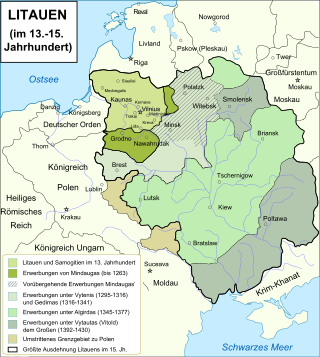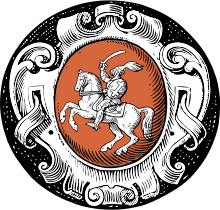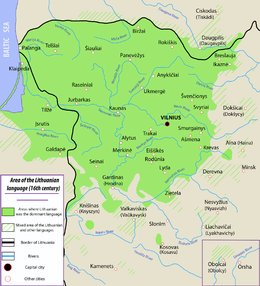Grand Duchy of Lithuania
This is the sighted version that was marked on April 15, 2021. There is 1 pending change that needs to be sighted.
![]()
The articles Grand Duchy of Lithuania and Golden Age (Belarus) overlap thematically. Information you are looking for here may also be in the other article.
You are welcome to participate in the relevant redundancy discussion or to help directly to merge the articles or to better distinguish them from one another (→ instructions).
The Grand Duchy of Lithuania, (Latin: Magnus Ducatus Lituania(e), literally: "Grand Duchy of Lithuania") Ruthenia and Schemaitia was a state existing in the Middle Ages and early modern times, which extended over the territory of the present-day states of Lithuania and Belarus, partly also Ukraine, Russian Federation and Poland. At the height of its power shortly before 1400, it reached as far as the steppe regions on the Black Sea. In 1386 it entered into a union with the Kingdom of Poland. Especially after the Union of Lublin in 1569, which established a common state of Poland and Lithuania, it was increasingly absorbed into the new Polish-dominated state. However, it disappeared as a political entity only in the course of the partitions of Poland.

The Rise of Lithuania as a Great Eastern European Power under Grand Duke Mindaugas I and his Successors - Territorial Development during the Late Middle Ages
History
→ Main article: History of Lithuania
The first impulses for state formation came in the 13th century under the influence of the expansion of the Teutonic Order, but the Kingdom of Lithuania under Mindaugas remained an episode. State consolidation did not take place until around 1300: Gediminas founded the capital Vilnius in 1323, which replaced Trakai Castle as the seat of the princes.
The Mongol invasion of Eastern Europe and the fragmentation of Kievan Rus, which had already begun, left a political vacuum in the region. Moreover, due to its northwestern location, Lithuania remained untouched by the Mongols' war campaigns. Thus, in the 14th century, especially under Grand Duke Gediminas and his sons Algirdas and Kęstutis, Lithuania's rise to a great Eastern European power took place.
Some partial principalities of Rus were subjugated, especially after the Battle of the Irpen, some also joined voluntarily in a period of weakness of the Golden Horde. In 1362, the Golden Horde was defeated at the Battle of the Blue Waters, the Lithuanian Grand Duke entered Kiev, and Belarus, Ukraine, and western Russia were thus under the supremacy of the Lithuanian Grand Princes. The political structures of the Eastern Slavic principalities were largely retained, but vassal principalities for the sons of Algirdas emerged, especially in the south. The Grand Princes of Lithuania henceforth saw themselves as the rightful heirs of the defunct empire of Kievan Rus. The following declaration of intent has been handed down from Algirdas: "Omnis Russia ad Litwinos deberet simpliciter pertinere" (German: "The whole Rus shall simply belong to the Lithuanians"). The later Polish-Lithuanian rulers bore the title magnus dux Littwanie, Samathie et Rusie.
In accordance with the majority of the population and the nobility, in the course of time the East Slavic culture became increasingly dominant in the Grand Duchy. Ruthenian became the official language of the Grand Duchy of Lithuania and remained so until about 1700.
The still pagan Grand Princes pursued a policy of religious tolerance during this period, which made the Grand Duchy of Lithuania attractive to European Jews as well as to numerous smaller groups such as the Caraeans.
In the west, the Lithuanian rulers faced a constant threat from the Teutonic Order. These Lithuanian wars could only be ended after the alliance with Poland and the Battle of Tannenberg in 1410.
After the Grand Duchy of Moscow had finally detached itself from Mongol rule around 1480, it became Poland-Lithuania's greatest competitor in the "collection of Russian soil" since the end of the 15th century, but especially since the beginning of the 16th century, as it also considered itself the legitimate successor of Kievan Rus.

Coat of arms of the Grand Duchy of Lithuania from the procession of princes in Dresden
Language
In the 13th century, the majority of the population in the center of the principality spoke Lithuanian, but it became a written language only in the 16th century. In the other parts of the state and in written documents, the Ruthenian language dominated. In addition, Latin and German functioned for diplomatic communication with Western states, and for matters with Eastern countries the court used Ruthenian. The three codifications of Lithuanian law from the 16th century, the Lithuanian Statutes of 1529, 1566 and 1588, were written in Ruthenian.
In the late period of the Grand Duchy, Polish became increasingly important, especially after the union with Poland. By 1697 Ruthenian had been largely replaced by Polish as the official court language, but was still used in a few documents until the second half of the 18th century. The upper class, i.e. the nobility of Lithuania became increasingly Polishized during the period of the Lithuanian-Polish Union, i.e. they adopted the Polish language and culture.
The Grand Duchy of Lithuania, as it was called in other languages:
- Вялікае Княства Літоўскае, Рускае, Жамойцкае - (Belarusian)
- Leedu Suurvürstiriik - (Estonian)
- Magnus Ducatus Lituaniae - (Latin)
- Lietuvos Didžioji Kunigaikštystė - (Lithuanian)
- Didi Kunigiste Letuvos - (Old Lithuanian)
- Lietuvas Lielkunigaitija / Lietuvas Lielkņaziste - (Latvian)
- Wielkie Księstwo Litewskie - (Polish)
- Великое князство Литовское, Руское, Жомойтское иных - (Ruthenian).
- Великое княжество Литовское, Русcкое, Жемойтское и иных - (Russian).
- Велике Князівство Литовське, Руське і Жемайтійське - (Ukrainian)

Lithuanian language area in the 16th century. This also included the northeastern part of the Duchy (later Kingdom) of Prussia ("Prussian Lithuania"), although politically this never belonged to Lithuania before 1945.
Questions and Answers
Q: What was the Grand Duchy of Lithuania?
A: The Grand Duchy of Lithuania was a European state from the 12th –13th century until 1569. It covered the land of present-day Belarus, Latvia, Lithuania and parts of Estonia, Moldova, Poland, Russia and Ukraine.
Q: Who started the Grand Duchy?
A: The Grand Duchy was started by the Lithuanians.
Q: When did Mindaugas become Catholic King of Lithuania?
A: Mindaugas became Catholic King of Lithuania in 1253.
Q: How did Gediminas allow people to practice different religions?
A: Gediminas allowed people to have different religions when he began ruling. This grew under his son Algirdas.
Q: Who changed the religion to Catholicism?
A: Jogaila changed the religion to Catholicism in 1386. He also made a dynastic union between the Grand Duchy of Lithuania and the Kingdom of Poland at this time.
Q: Who led the defeat against Teutonic Knights in 1410?
A: Vytautas the Great led the defeat against Teutonic Knights in 1410 during what is known as The Battle of Grunwald.
Q: What happened after Vytautas's death?
A: After Vytautas's death, Lithuania's relationship with Kingdom of Poland deteriorated and eventually resulted in Union of Lublin which created Polish–Lithuanian Commonwealth in 1569.
Search within the encyclopedia